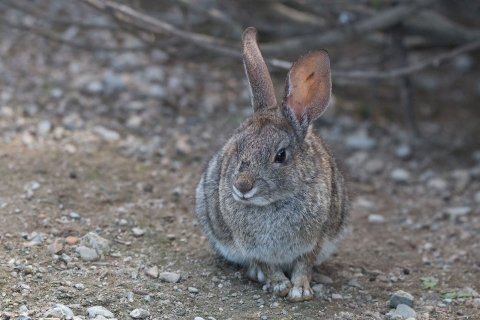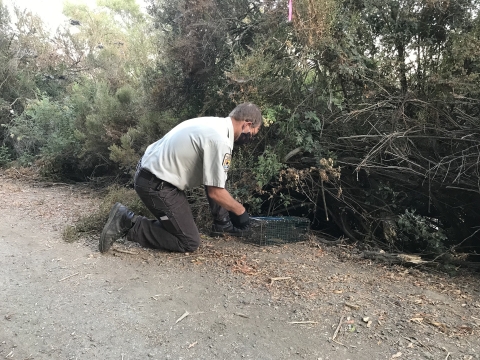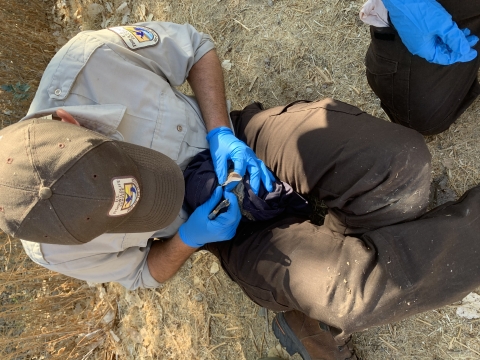Definition of riparian habitat or riparian areas.
Learn more about riparian brush rabbit is found only in California’s Central Valley and could be impacted by a deadly virus new to wild rabbits in North America. | Image Details
Under the hot summer sun, Eric Hopson, assistant refuge manager for the San Joaquin River National Wildlife Refuge, set traps to capture live, endangered riparian brush rabbits on the refuge. Brown and white with a fuzzy cottontail, the riparian brush rabbit was once believed to be extinct, but a remnant population was discovered in San Joaquin County and reintroduced to the refuge. Recovery efforts improved the population, but the successful work could be derailed by a highly infectious virus that appeared in wild rabbits for the first time this spring.
In an eerie parallel to the pandemic sweeping across the human population, the rabbit hemorrhagic disease virus serotype-2 (RHDV2) was first observed in wild rabbits in March 2020. While the virus was known to infect domestic rabbits, its discovery in wild populations in the United States was alarming.
“We needed to capture some of the riparian brush rabbits on the refuge and bring them into captivity temporarily while the safety of a vaccine was determined,” said Hopson.
A subspecies of the more common brush rabbit found in Oregon, California and Baja California, the riparian brush rabbit is only found in California’s Central Valley. Full-grown adults are about 12 inches in length and weigh 1.5 pounds. Since 2001, the Service and its partners have been working to restore habitat and reestablish a population of riparian brush rabbits on the San Joaquin River NWR. It is among the most endangered mammals in the state.
“During the past two decades, recovering the species has been a major refuge objective,” said Kim Forrest, refuge manager of the San Luis National Wildlife Refuge Complex. “We started with a very small number of rabbits, and through our efforts with a number of partners to create better habitat, remove threats and release captive-bred individuals, we estimate that there’s up to 2,000 rabbits on the refuge now.”
Before March, the biggest threat to the rabbits was winter flooding, but the virus poses an unexpected and potentially catastrophic threat.
“Rabbit hemorrhagic disease virus serotype-2 is new to wild rabbits in North America, so they do not have any natural immunity,” said Stephanie Prevost, wildlife biologist in the Sacramento Fish and Wildlife Office. Prevost worked to devise the emergency response plan with an interagency team while Josh Emery, senior wildlife biologist in the office, wrote the biological opinion that approved the emergency capture and vaccination efforts.
In domestic rabbits, the fatality rate for those that contract the virus can be up to 90 percent. Biologists think the results could be the same for wild rabbit populations, which would not bode well for the riparian brush rabbit.
“We’re still learning how this virus is transmitted among wild rabbits. The virus is likely spread rabbit-to-rabbit, but it can also spread through close contact with contaminated feces or food. The virus is persistent in the environment and doesn’t die very easily,” she said.
Quick to recognize the threat, the Service, California Department of Fish and Wildlife, U.S. Geological Survey, Oakland Zoo, River Partners and the California Department of Food and Agriculture developed a plan that had three major components: 1) capture and house a small group of riparian brush rabbits at the Oakland Zoo which could be used to repopulate conserved lands if the virus killed the majority of the wild population; 2) conduct a vaccination safety trial; and 3) vaccinate wild riparian brush rabbits.
With no time to lose, representatives from the various organizations set out to complete the objectives.
During the month of August, 20 brush rabbits were captured on the refuge and moved to an indoor, bio-secure area at the Oakland Zoo. The zoo provided regular check-ups and administered a vaccine that’s available to domestic rabbits. With careful monitoring, the zoo determined that the vaccine was safe to administer to wild rabbits and would hopefully provide them with the defenses needed to combat the virus.
“Caring for the rabbits in a biosecure laboratory was necessary so they wouldn’t contract the virus through an unknown source. We’re very thankful for all of the resources the zoo dedicated to taking care of these rabbits,” said Prevost.
Since the vaccine was manufactured in France, the California Department of Food and Agriculture applied for and secured a vaccine import permit to get access to bulk quantities of the vaccine quickly. This enabled the California Veterinary Medical Association to order, and subsequently donate, 270 vaccines to the effort.
“We’re so grateful for the support the entire science community has provided to this effort and how quickly it all came together. This has been a very successful collaboration that achieved the goals we established,” said Prevost.
In October, staff from the refuge, River Partners, the Endangered Species Recovery Program at California State University Stanislaus, and CDFW began vaccinating wild riparian brush rabbits. Trapping efforts required staff and partners spending three to four days a week out on the refuge setting and checking traps. After receiving the vaccination, the rabbits received a small metal tag in their right ear. The tags help biologists quickly differentiate which rabbits were given vaccinations, and which rabbits are still at-risk.
“Trapping the rabbits is not easy, but we have captured and vaccinated over 200 brush rabbits without incident during the past three months at the refuge,” said Fukima Takahashi, refuge biologist.
The captive rabbits being held at the Oakland Zoo were released back onto the refuge in late October and early November. While the virus’s progression north seemed to slow over the summer, biologists are expecting the disease to move more quickly during the winter and spring months.
The dedicated individuals and agencies part of the effort will continue to work together over the coming months to devise the next plan which will address actions needed when the virus is observed on the refuge. While the vaccinations will hopefully protect a portion of the rabbit population, much remains to be seen.
“The slowdown of the virus’s progression during the summer gave us much needed extra time that we didn’t expect. That said, this isn’t the end of the story. The collaboration gives me a lot of hope for the effort moving forward and for the future of the rabbit,” said Prevost.








